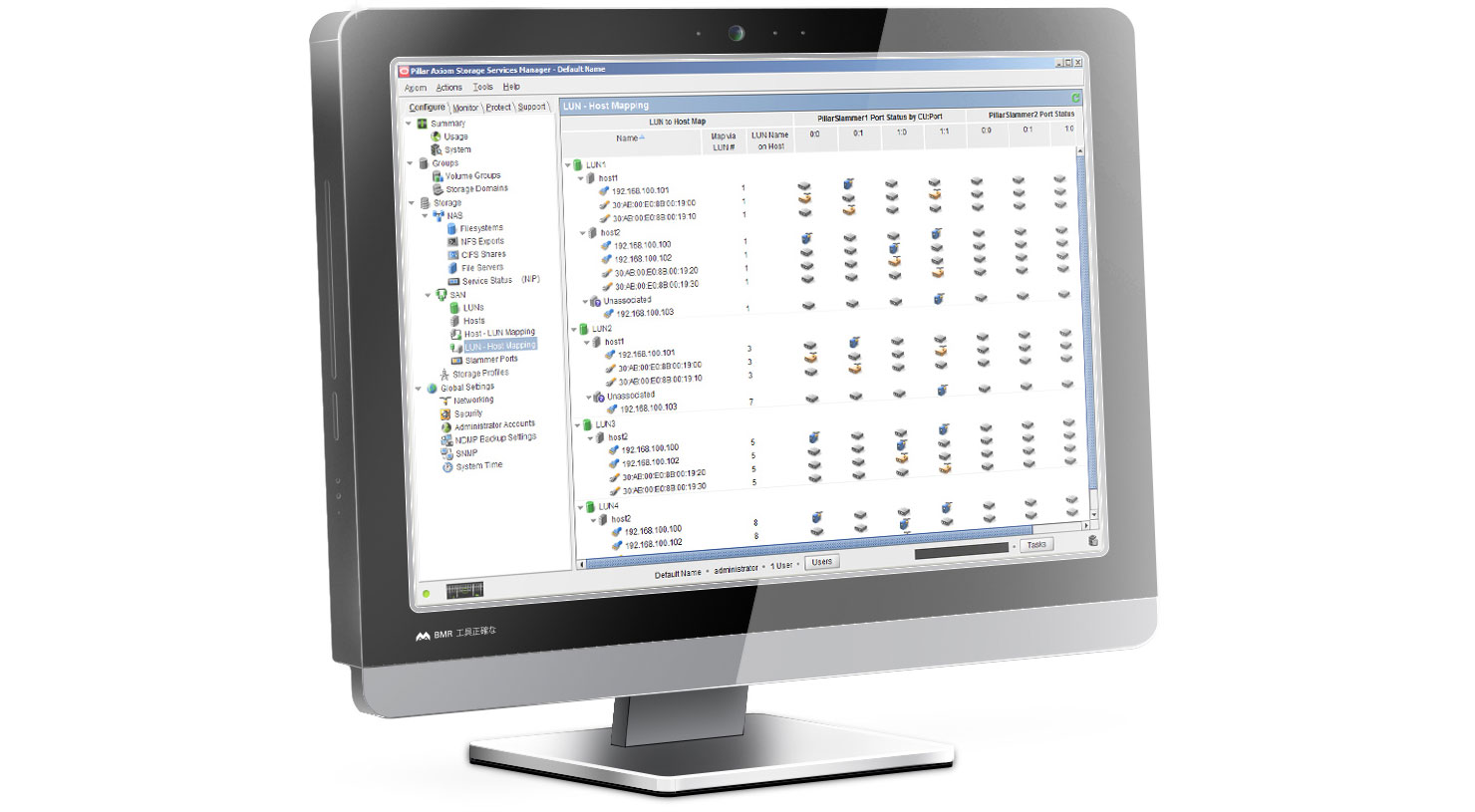Axiom Storage Services Manager
Pillar Data Systems, a data storage solutions company, undertook to reconstruct its key software program, the Axiom Storage Services Manager, which controls the hardware of its server systems.
T
his challenged us to create solutions based on the box art. Normally the box art was done at a very high resolution but limited to the box graphics itself. This set of resources was greater, and supplied multiple of secondary images such as those that became the playing cards, and the screenshots used in the strategy guide.
I do admit this was the one time in my career that I found a use for the typeface Papyrus. It had been on the Mac operating system for two years and when creating the strategy guide about the art of ancient warcraft it seemed fitting.
Strategy
I began with an analysis of the successes and failures of the current interface and a comparison to competition’s interfaces. I continued by studying the company’s identity system manual to ensure the proposal matched the company’s standards. Research was conducted to determine how icons were used historically in the Windows environment and how other data storage managment software had represented complex ideas such as a storage domain.
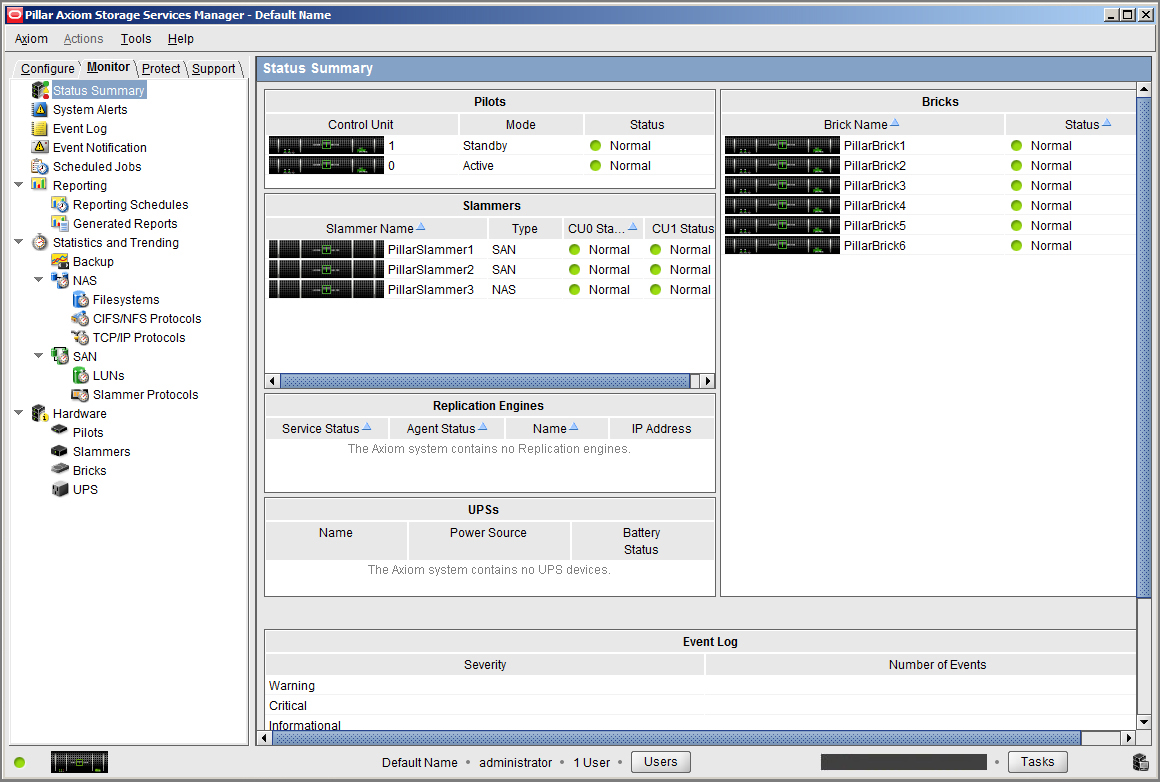 Pillar Data Systems Axiom Storage Services Manager, versions 3 – 5
Pillar Data Systems Axiom Storage Services Manager, versions 3 – 5
Discipline:UX / UI
Client:Pillar Data Systems / Oracle
Year: 2006–2010
Project Challenges
1. Overcome language barrier. I had to learn the vocabulary of the IT Networker. A language where what I would know as servers, or hard drives was labeled Storage Domains, Volumes , or Consistency Group. How these storage domains were structured made them SAN or NAS with details such as Host Groups and Exports etc.
2. Translate. Once I learned the new terms I was tasked with converting the terms into pictorial representations meaningful to the IT Networker.
3. Combine. Newly created icons required incorporation with industry established icons.
4. Unify. All visuals required adjustment to create a cohesive system.
5. Compress. Size requirements necessitated the compression of these complex pictorial representations into an 18 x 18 pixel space. Many of the existing program icons were as large as 32 x 32 making the transition to the custom size of 18 x 18 a challenge.
Minuscule Icons
I was able to create consistency despite the challenge of changing size. Many times the concept represented was best displayed using a combination of icons. So each icon had to have two sizes — full size (main), and smaller (secondary).
 Axiom Storage Services Manager Volume & Hardware Icons
Axiom Storage Services Manager Volume & Hardware Icons
Communicating complex system functionality required a serious and simple design. Fortunately dramatic stylization wasn't necessary for the market. The software engineers wanted the interface to represent (at the time) the world's ultimate server operating system, Windows XP. The only touch of style we could afford was highlight and shadow, and out of necessity, occasional isometric perspective (you just can’t represent a cylinder as a straight on view).
Translating vocabulary into pictograms and ideograms may sound like a simple and straightforward project however drawing a cylinder, complete with highlight and shadow, in a 6 pixel by 10 pixel space presents a design challenge. Anti-alisis is often called hinting, when only have 30 pixels are available in which to draw dimensional shapes 50% of the image is hinting!
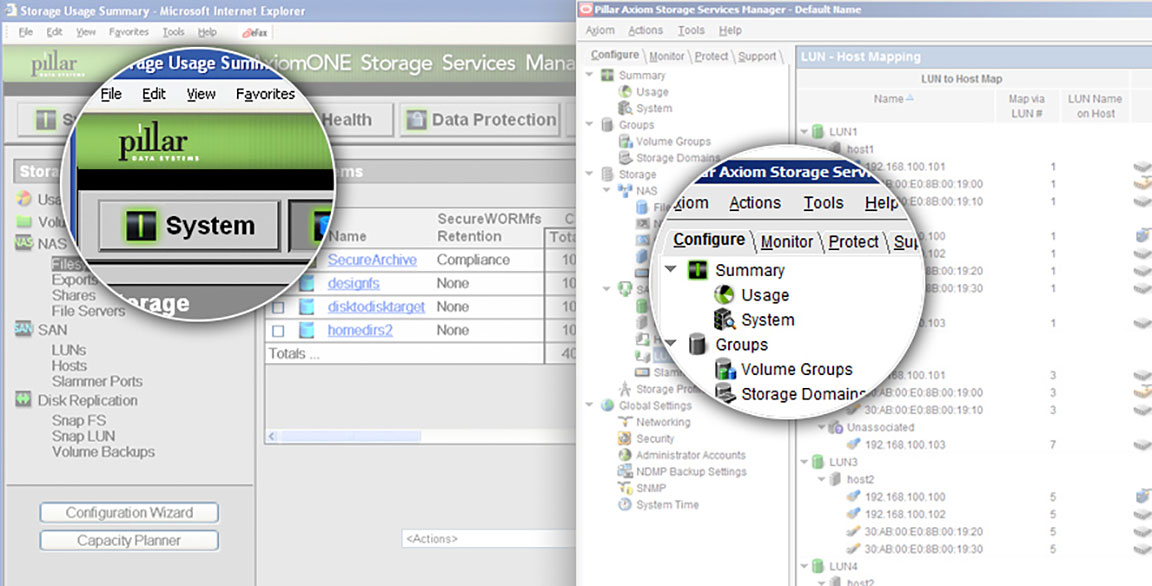 Graphic User Interface Design
Graphic User Interface Design
Before
Awkward buttons and wasteful use of navigation space.
After
Replaced with slick tabs and a careful use of space allowing for more information in the same area.
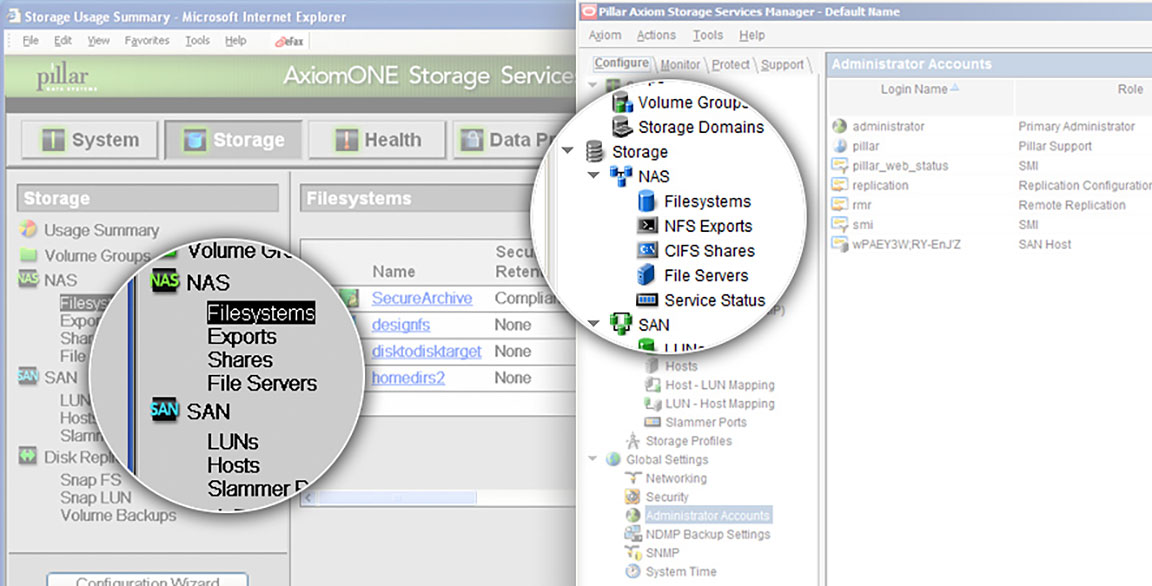 Graphic User Interface Design
Graphic User Interface Design
Before
Acronyms for icons and missing icons for navigation
After
A strong set of rational symbols that can be combined to represent larger more complex ideas.
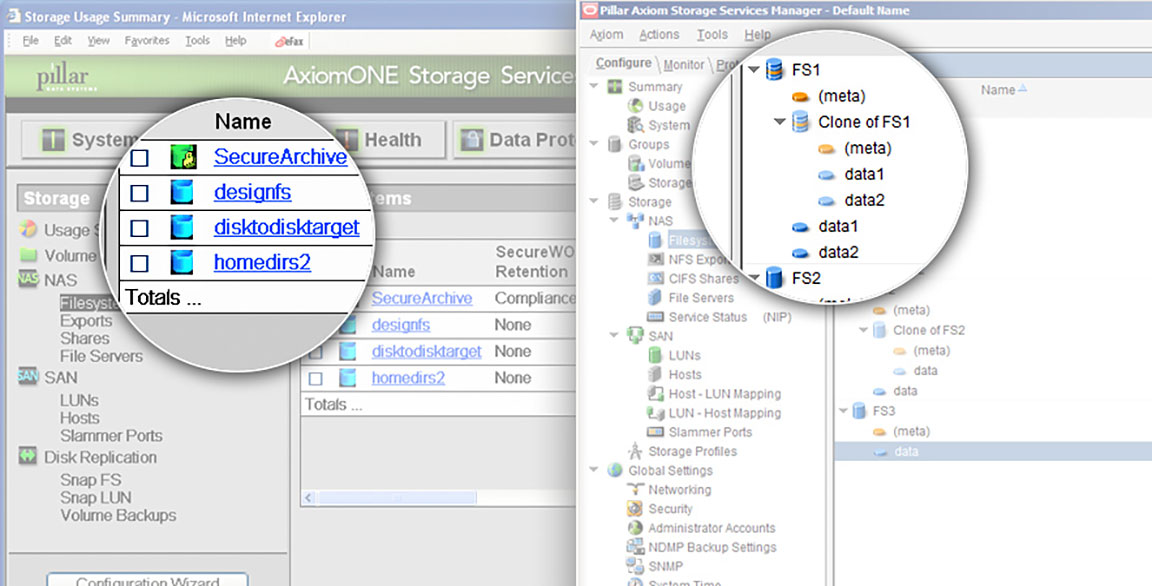 Graphic User Interface Design
Graphic User Interface Design
Before
No icons representing multi-tered server volumes or a way to represent the server being divided into managable sections.
After
A clear visual representation of server volumes and how they can be divided, backed-up and managed.
Icon Color Pallet
A large color pallet allowed the small and complex overlapping icons to be individually recognizable.
 Experimentation leads to the best solutions. These are draft images for the Primary Storage Domain and New Hardware icons.
Experimentation leads to the best solutions. These are draft images for the Primary Storage Domain and New Hardware icons.
Colors were matched to the previous system whenever possible and the existing program's use of blue and green to represent SAN and NAS respectively remained consistent. A large color pallet helped display the icons as clearly as possible. The issue of color blindness was considered and treated by ensuring the values were different enough that those with any degree of red/green or blue/yellow color blindness could recognize a difference between colors.
Over 30 usability tests and informal walk-throughs were conducted. These studies included review by system administrators, current customers, and company sales engineers. Input was gathered and applied. Icons were adjusted, and interface layout altered. A successful balance was struck in maintaining the former look and feel of the interface to accommodate existing users while introducing a software interface that was drastically more complex.
 Experimentation leads to the best solutions. These are draft images for the Primary Storage Domain and New Hardware icons.
Experimentation leads to the best solutions. These are draft images for the Primary Storage Domain and New Hardware icons.
Compound Icons
Much of the program’s functionality was too complex to be represented by a single symbol. Consequently, the icons became a combination of two symbols, in some cases three. For example, an icon representing the CMP Virtual Machine Configuration Manager (cloud computing) features a gear (representing preference settings, clouds (cloud computing) and a computer (network storage rack).
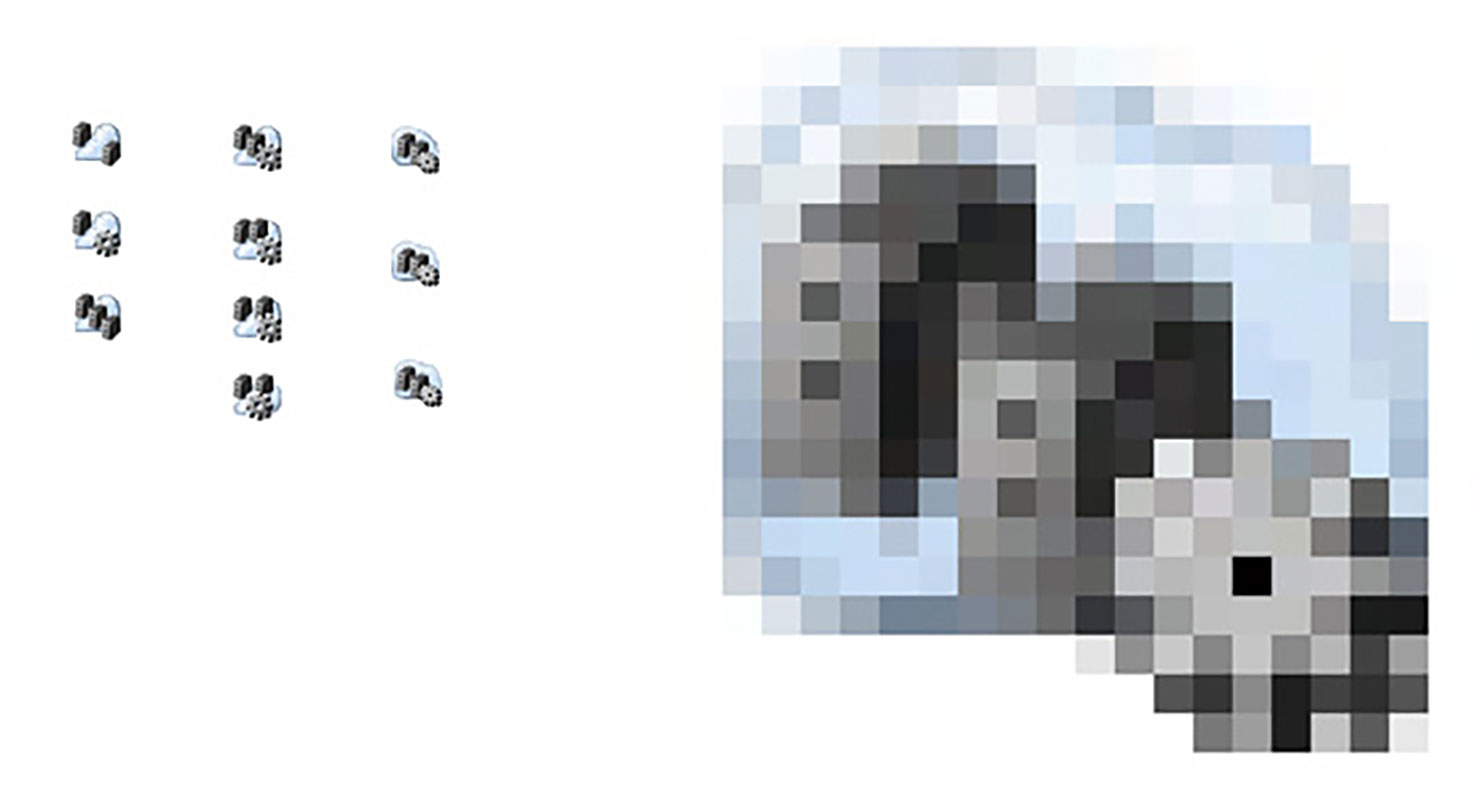 Enlarged: Various icons representing cloud computing. The close-up shows the challenge of fitting four icons into this 18x18 pixel space.
Enlarged: Various icons representing cloud computing. The close-up shows the challenge of fitting four icons into this 18x18 pixel space.
Effectiveness
The Axiom Storage Service Manager was released in early 2011. The product has been well received by the industry. It won theBest Cloud Storage Solution award on June 21, 2011. Six days later Oracle announced it would acquire Pillar Data Systems.
Universal Communication
The Axiom Storage Service Manager is a product used by IT professionals around the globe and therefore the GUI was designed to present a universal language for the global marketplace. Care was taken during the design process to create a look that was not “American” or even “Western.”
 Enlarged: Axiom Storage Services Manager Old Icons Compared to New.
Enlarged: Axiom Storage Services Manager Old Icons Compared to New.
